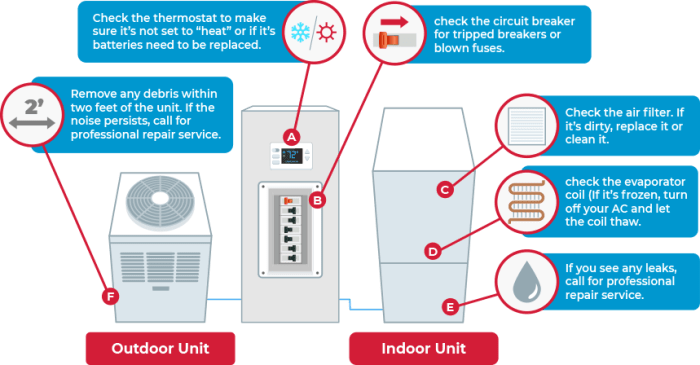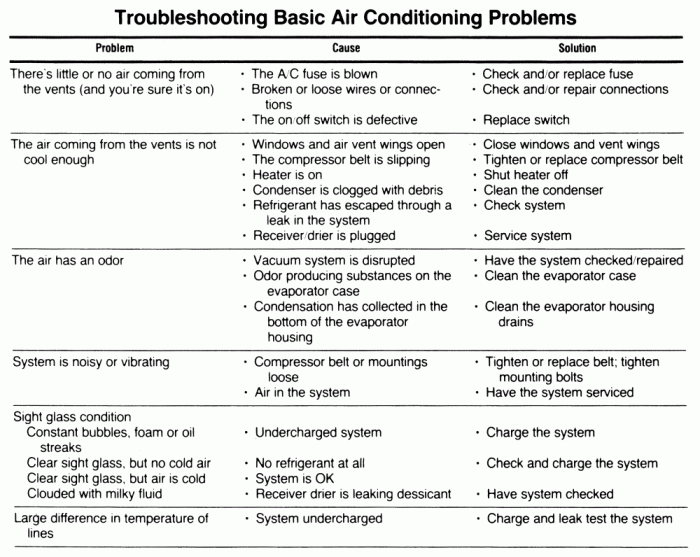Embark on a journey through the basics of air conditioner troubleshooting with this guide tailored for beginners. From understanding the inner workings of AC units to tackling common problems, this guide aims to equip you with the knowledge needed to keep your space cool and comfortable.
Understanding the Basics of Air Conditioners

Before diving into troubleshooting, it's important to understand the basic components and functioning of an air conditioner.
Primary Components of an Air Conditioner
- Compressor: Responsible for circulating refrigerant through the system.
- Condenser: Releases heat absorbed from the indoor air outside.
- Evaporator: Absorbs heat from indoor air and cools it down.
- Expansion Valve: Regulates the flow of refrigerant into the evaporator.
How an Air Conditioner Works
An air conditioner works by removing heat from indoor air and expelling it outside. This process involves the refrigerant circulating through the compressor, condenser, expansion valve, and evaporator to cool down the air.
Common Types of Air Conditioning Systems
- Central Air Conditioning: Uses ducts to distribute cooled air throughout the entire building.
- Split Air Conditioning: Consists of indoor and outdoor units connected by refrigerant lines.
- Window Air Conditioning: Compact units installed directly in windows to cool specific rooms.
Common Air Conditioner Problems
When it comes to air conditioners, beginners may encounter a few common issues that can affect the performance of the unit. Understanding these problems can help you troubleshoot and address them effectively.
Air Conditioner Not Cooling Properly
One of the most common issues with air conditioners is when they are not cooling the room as expected. This can be caused by a variety of factors, such as:
- Dirty air filters restricting airflow
- Refrigerant leaks leading to insufficient cooling
- Blocked or dirty condenser coils affecting heat transfer
Air Conditioner Not Turning On
If your air conditioner is not turning on at all, it can be frustrating, especially during hot weather. Here are a few steps you can take to troubleshoot this issue:
- Check the power source to ensure the unit is receiving electricity.
- Inspect the thermostat settings to make sure they are correctly configured.
- Look for any tripped circuit breakers that may need to be reset.
- Examine the air conditioner's fuse to see if it needs to be replaced.
Safety Precautions and Maintenance Tips

When troubleshooting air conditioners, it is crucial to prioritize safety to prevent accidents and injuries. Regular maintenance also plays a key role in ensuring the efficiency and longevity of your air conditioner. Here are some safety precautions and maintenance tips for beginners:
Safety Guidelines for Beginners
- Always turn off the power before inspecting or working on your air conditioner to avoid electric shock.
- Use insulated tools when handling electrical components to reduce the risk of shock.
- Keep the area around the air conditioner clear of debris to ensure proper airflow and prevent overheating.
- Wear protective gear such as gloves and goggles to protect yourself from sharp edges and cleaning chemicals.
Importance of Regular Maintenance
Regular maintenance not only improves the efficiency of your air conditioner but also extends its lifespan. By cleaning and inspecting your unit regularly, you can identify and address minor issues before they escalate into major problems, saving you time and money in the long run.
Cleaning Air Filters and Coils
- Check and clean the air filters every 1-2 months to ensure optimal airflow and prevent dust buildup.
- Use a vacuum or mild detergent to clean the filters and allow them to dry completely before reinstalling.
- Clean the evaporator and condenser coils annually to remove dirt and debris that can hinder heat transfer.
- Use a coil cleaner or a solution of water and mild detergent to gently clean the coils, taking care not to bend the fins.
Step-by-Step Troubleshooting Guide
In this section, we will provide a step-by-step guide for beginners to troubleshoot common air conditioner problems.
Checking Power Sources
- Make sure the air conditioner is plugged in and the power source is working properly.
- Check the circuit breaker to ensure it has not tripped.
- Verify that the power switch on the unit is turned on.
Thermostat Settings
- Check the thermostat settings to ensure they are set to cool and the temperature is lower than the room temperature.
- Replace the batteries in the thermostat if it is not responding.
Air Filters
- Inspect the air filters for dirt and debris, and clean or replace them if necessary.
- Dirty filters can restrict airflow and cause the unit to work harder, leading to inefficiency.
Identifying and Addressing Refrigerant Leaks or Unusual Noises
- If you notice a refrigerant leak, contact a professional technician immediately to avoid any safety hazards.
- Unusual noises such as grinding, squealing, or banging could indicate a problem with the compressor or other internal components.
- Turn off the unit and seek assistance from a professional if you hear any unusual noises.
Final Summary
In conclusion, mastering the art of air conditioner troubleshooting as a beginner is within reach with the right knowledge and guidance. By following the steps Artikeld in this guide, you'll be well-prepared to handle any cooling issues that come your way.
Detailed FAQs
Why is my air conditioner making strange noises?
Your air conditioner might be making unusual noises due to loose components, debris in the system, or issues with the fan. It's best to turn off the unit and consult a professional for a thorough inspection.
How often should I clean my air filters?
It's recommended to clean or replace your air filters every 1-3 months to ensure optimal performance and air quality.
What should I do if my air conditioner is leaking water?
If your air conditioner is leaking water, it could be due to a clogged condensate drain line. You can try to unclog it with a wet/dry vacuum or contact a professional for assistance.













